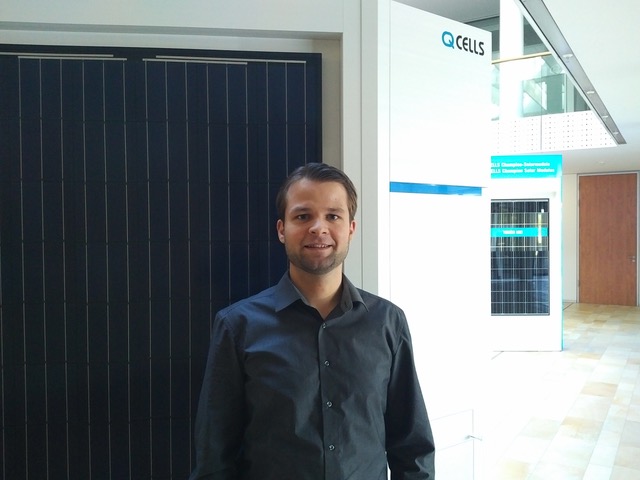Looking at the past, present and future of solar, Maximilian believes that photovoltaics and the industry as a whole are have completely transformed since he started out just nine years ago in 2010.
Being involved in the development of new technologies and products, whilst also supporting our sales, marketing and communication departments with technical backgrounds and customer communication, means that I have an in depth overview of most facets of Hanwha Q Cells and the solar industry as a whole.
As with most in-demand technologies, photovoltaics are almost unrecognisable today compared to 20 years ago. While on the surface a solar panel of today does not look too dissimilar to one made in 1999, beyond the facade much has changed – most specifically in terms of efficiency, power output and cost. The levelised cost of electricity (LCOE) offered by solar today is as low as $57/MWh – in 2009 that figure was $350/MWh. Figures have shown that solar PV costs have fallen by 84% since 2010, and have fallen 18% in the past 12 months.
The direction of travel will continue downwards as solar cell and module manufacturers such as Q Cells continue to invest in R&D and innovation to deliver new and improved solar technologies at ever lower costs.
Beyond the technology, the industry itself has matured in many encouraging directions. 20 years ago, solar energy barely made a ripple on the world’s electricity supply. In 1999, there was less than 1 GW of new PV capacity added globally. Last year, more than 100 GW of new capacity was installed around the globe – and that figure will grow even more in 2019. Geographically, the industry continues to broaden, and while China, the US and India continue to account for almost half of all installations, many new and emerging markets are growing at a faster rate.
What are the current trends in solar worldwide?
The main trend is cost reduction-per-kWh. As a result of economies of scale and production cost reduction on the one hand, and via increasing efficiency and power output on the other. Not just solar, but wind power and battery storage technology too – all three technologies are on a staggering cost- competitive path, and are driving a low-carbon energy transition in most major economies. This is putting pressure on governments to divest from fossil fuels, to close old and expensive coal plants, and shelve plans for new coal plants. We see this trend happening the world over, and while we should not take for granted that it will continue, history shows us that as soon as the economic argument makes sense – which it certainly does for solar and wind, backed by storage – then change happens quickly.
What are emerging challenges in solar technology over the next decade?
Solar technology thrives on facing challenges and overcoming them. Solar R&D departments around the world – including Q Cells’ own in Germany and Korea – are constantly scanning the horizon to develop new ways to effectively and efficiently draw power from the sun. Developing ways to do this that are reliable, stable and – most importantly – cost-effective, will always be the overarching challenge for the solar industry.
More broadly, however, it is important that these researchers and developers are able to conduct their work in an environment that is supportive of their innovation, and under the assurances that their intellectual property and eventual products will be protected. Without such assurances, innovation will cease.
Other challenges are more market-driven. Looking at the industry consolidation over the past five years, it will be vital to ensure the continuation of a diversified and vibrant landscape across the solar sector throughout different parts of the world. A scenario where manufacturing capability is consolidated among just a few companies is potentially quite harmful for the industry’s ability to continue to innovate, keep price reductions stable, and ensure that new and emerging markets have access to this wonderful technology.
But I am confident that the solar industry will continue to mature in the right way, and as more and more PV is installed, then it becomes vital to ensure that grids are adaptable to the specific demands of solar, which as we know is a variable energy source. This is where affordable storage technology becomes an even more integral part of the jigsaw puzzle.
The views and opinions expressed in this article are the author’s own, and do not necessarily reflect those held by pv magazine.
This content is protected by copyright and may not be reused. If you want to cooperate with us and would like to reuse some of our content, please contact: editors@pv-magazine.com.



The focus should be on reducing PV System Costs and NOT PV Panels alone…. already the cost of PV Panels themselves are about 20-40% of System Costs.
As the Cost of PV Cells reduce, the “parasitic costs”….. Glass, Sheeting, Frame, Handling etc… are now dominating the cost of the PV Panels.
Improvement in Efficiency provides a “lot of bang for the buck”…. as it also “parasitic costs”…. but the gains are getting more and more difficult, as these benefits are being squandered away by “System Costs”(Installation, Structures, Land, Labor, Permits, Hearings, Time/Interest, etc…).
I believe, the Industry, with TOTAL SOCIETAL SUPPORT requires an “Integrated Solution” to reduce “Overall Costs” …
AgriVoltaics is the “way forward” for meeting “The Green Deal” Zero Pollution Energy Systems requiring Multi-TW Size Solar ENERGY (NOT JUST ELECTRICAL) Systems in the US and around the Globe (150TW around the Globe for ALL ENERGY NEEDS)…
ONLY AGRIVOLTAICS USING <10% of 17Million KM2 of Agricultural Land can "provide a home" for these PV Systems….. WITHOUT USING ADDITIONAL LAND OR REDUCING AGRICULTURAL OUTPUT TOO….
Why look for "creative/niche solutions" when the answer is right here…. just like Solar Energy…. where you look up in the day and see the sun providing ALL of Mankinds "appetite" for Energy…